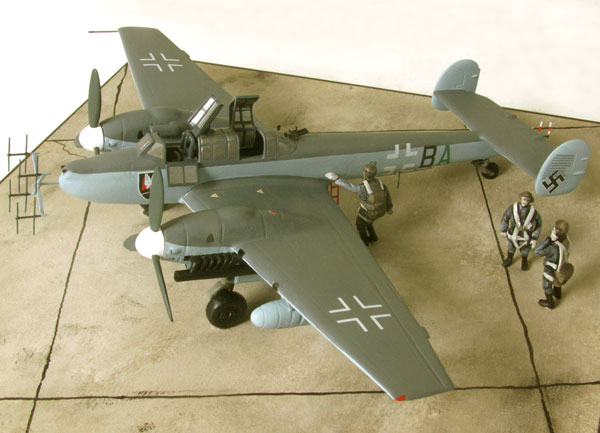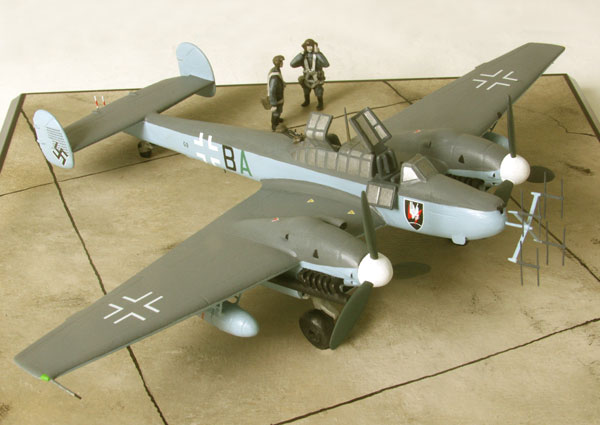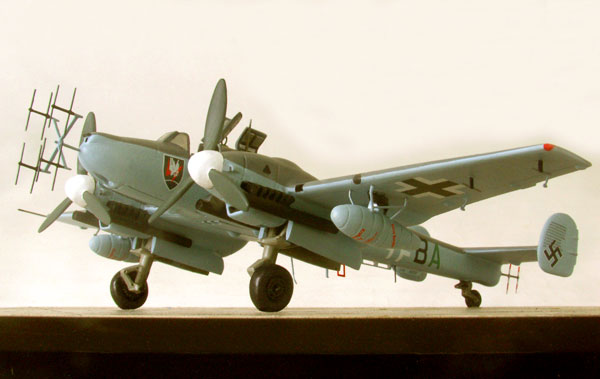Messerschmitt Bf 110G-4
Messerschmitt Bf 110G-4 ‘G9+BA’ Major Heinz Wolfgang Schnaufer,
Geschwaderkommodore NJG 4, Schleswig, March 1945.
Although Germany’s leadership were convinced that the war they were about to launch in 1939 would be fought on the territory of other nations, British bombs began falling on the Reich within days of the outbreak of hostilities. RAF Bomber Command’s change in strategy from diurnal to nocturnal operations in late 1939, following unacceptable losses during daytime sorties against the Northern German ports, created a corresponding need for the Luftwaffe to develop an effective night fighter defence force.
In July 1940, Oberst Josef Kammhuber was appointed to oversee establishment of the first night figher unit, Nachtjagdgeschwader (NJG) 1. Kammhuber’s initial crews were recruited from the day fighter units of the Zerstörergeschwader at a time when their Messerschmitt Bf 110 C twin engine aircraft were found wanting in the bomber escort role during the Battle of Britain. In spite of its formidable forward firepower, the Messerschmitt Bf 110C’s lack of agility in the air made it short on performance when matched against the RAF’s redoubtable single-seat fighters directed by state of the art systems of air defence. However, once reallocated to night fighting duties, the Messerschmitt Bf110 found its metier, and was to play a distinguished role in the defence of the Third Reich. Since efforts to replace the Bf 110 with more advanced aircraft such as the Me210 and Me410 were ineffective, improved variants of the Bf 110 persisted in operational service until the end of the war.
In contrast to the Bf 110Cs that equipped the Nachtjagdgeschwader in 1940-41, the Messerschmitt Bf 110G variant of Messerschmitt’s design was the first type specifically intended for the night fighter role. It entered production in June 1942. In comparison to the Bf 110C, the night fighting G4 variants had more powerful DB605B-1 engines and marginally re-engineered structure and systems. The addition of radar aerials and night fighting equipment inevitably resulted in a loss of aerodynamic performance. Nonetheless the Messerschmitt Bf 110G presented the Nachtjagdgeschwader with an outstanding weapon to combat RAF bomber command’s offensive during 1942-45.
Bf 110G’s were arrayed with varying types of radar systems (such as FuG 202, FuG 212 and FuG 220 SN-2 variations of Lichtenstein, and FuG 218 Neptun) and armed with powerful forward firing canon and machine guns, supplemented in some cases by the vertically inclined Schräge Musik (Jazz Music) installation with paired MK108 canons projecting obliquely through the rear of the canopy. This upward firing weapon was particularly effective in targeting the unprotected bellies of RAF bomber command’s aircraft and it is estimated to have been used in half of all the night fighter attacks towards the end of the war. Attacks with Schräge Musik cannons presented something of a mystery to some RAF crews. As Lancaster rear gunner Leonard J. Isaacson has reported of a suspected attack using this weapon “We had dropped our bombs on a synthetic-oil plant in Gelsenkirchen, Germany the night of June 12/13, 1944 and were headed for base. In the tail gun turret I was searching in the dark for any enemy fighters who might be following us out of the target area. Suddenly I heard cannons barking loudly and saw lights flashing directly below. What the hell was that? I didn’t see the fighter – just the flashing. We took evasive action and that was it”. In spite of this startling encounter, Leonard Isaacson completed his tour of 31 Operations on August 30, 1944 and survived the war.
Messerschmitt Bf 110G-4 ‘G9+BA’ was flown by the Luftwaffe’s highest scoring night fighter ace Major Heinz Wolfgang Schnaufer. This particular machine represents his last mount of the war and is equipped with advanced equipment including the Seimen’s FuG 218 Neptun radar, a Schräge Musik paired cannon installation, and the late war Eberspächer single flame damping exhausts. In keeping with the production and supply limitations imposed by end of war conditions, G9+BA wears an austere camouflage scheme in which dorsal surfaces of the wings and fuselage are painted in a defined single grey tone of RLM 75 with RLM 76 painted flanks and undersurfaces. This is in contrast to the more frequent two-tone grey splinter pattern (RLM 74/75) and mottling type camouflage seen on the upper surfaces and sides of many Bf 110G’s deployed in the night interceptor role.
Flying Messerschmitt Bf 110’s, Major Schnaufer and his crew claimed 121 victories during 164 operations with NJG 1 and 4. His first night operation, flying one of 5 / NJG 1’s entirely black painted Messerschmitt Bf 110Cs out of St Trond in Belgium, was in response to the RAF’s attack on Essen on the 2/3 June 1942. Later in the war Major Schnaufer would hone his night interception skills to such a degree that he could distinguish between the Lancaster and Halifax bombers merely by the pattern of their exhaust emissions. Commenting on how RAF gunners defended themselves Heinz Wolfgang Schnaufer is reported to have said “They do not fire nearly enough rounds, or open fire soon enough, for fear of giving away their position”. By contrast the RAF bomber crews expressed no such reservations about their adversary. Major Schnaufer’s highly effective tactics earned him the sobriquet of “The Night Ghost of St Trond”. His last three aerial victories were recorded during the night of March 7/8 1945 by which time Heinz Wolfgang Schnaufer held the rank of Kommodore of NJG 4. Major Schnaufer was captured by the British at the end of the war and released to civilian life following interrogation. The post-war fate of his Messerschmitt Bf 110G-4 ‘G9+BA’ is less certain. What can be stated as fact is that the two tail fins, each of which was painstakingly decorated with his tally of 121 kills, represented by tiny aircraft symbols appended with a date, survive to the present day. The port fin now resides in the Imperial War Museum, in South London and the starboard fin can be found in the Australian War Memorial in Canberra.
Scale 1:72 Wingspan 8.9″ (225.8 mm)
Base size 9.33″ (237 mm) square (No. 6)
Weight not including base 1lb 2ozs ozs (511 grams) Limited edition of 25 only
SOLD OUT




